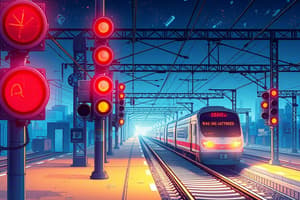Podcast
Questions and Answers
What is the meaning of 'IBsignaldefective'?
What is the meaning of 'IBsignaldefective'?
- Intermittent Block signal defect
- Internal Block signal defect (correct)
- Inbound signal defect
- Interlocking Barrier signal defect
When can a signal be treated as defective?
When can a signal be treated as defective?
- When the departure signal is defective (correct)
- When the track circuit is clear
- When the gate signal is on
- When the automatic signal is on
What should be done when 'Hot axle/Hot Box' is detected?
What should be done when 'Hot axle/Hot Box' is detected?
- Ignore and continue the journey
- Increase the speed of the train
- Apply emergency brakes immediately (correct)
- Check for loose bolts in the engine
What are the indications of 'Head Light, Flasher Light, and Marker Light'?
What are the indications of 'Head Light, Flasher Light, and Marker Light'?
What does CTR stand for?
What does CTR stand for?
Flashcards
IBsignaldefective meaning
IBsignaldefective meaning
Internal Block signal defect
Defective signal condition
Defective signal condition
When the departure signal is faulty
Hot axle/Hot Box
Hot axle/Hot Box
Apply emergency brakes immediately
Head Light, Flasher Light, Marker Light
Head Light, Flasher Light, Marker Light
Signup and view all the flashcards
CTR meaning
CTR meaning
Signup and view all the flashcards
Study Notes
General Rules and Subsidiary Rules
- General rules provide overarching regulations applicable in various contexts, while subsidiary rules address specific scenarios or exceptions.
Block Station and Non-Block Station
- Block stations facilitate the stopping and starting of trains, ensuring safe movement through controlled areas.
- Non-block stations do not have dedicated personnel for managing train movements, leading to less stringent controls.
Interlocking
- Interlocking is a safety mechanism used to prevent conflicting train movements through controlled signaling.
Obstruction
- Obstruction refers to any condition or event that delays or prevents the movement of trains along a track section.
Authority to Proceed
- Permission granted to a train driver to proceed past a signal, often under specific conditions.
Block Section
- A block section is a defined segment of track that is controlled to ensure no two trains occupy the section simultaneously.
Distance Signal
- Distance signals indicate to train drivers the status of upcoming signals and facilitate safe traveling over long distances.
IB Signal
- IB signals (Intermediate Block Signals) are placed between two block stations, providing additional safety and control for train movements.
Fog Signal (Detonator)
- A fog signal is a warning device used during low visibility conditions, often activated by the approach of a train to alert the crew.
Calling On Signal
- A calling on signal allows a train to proceed into a block section that is temporarily occupied or in adverse conditions.
Shunt Signal
- Shunt signals direct locomotives and rolling stock to move within yards or rail sidings, facilitating switching and positioning.
Short Notes on Signals
- A thorough understanding of signals is crucial in railway operations for safety and efficient management of train movements.
Studying That Suits You
Use AI to generate personalized quizzes and flashcards to suit your learning preferences.




